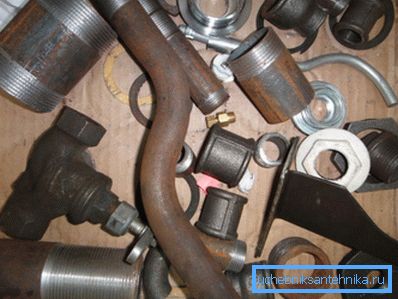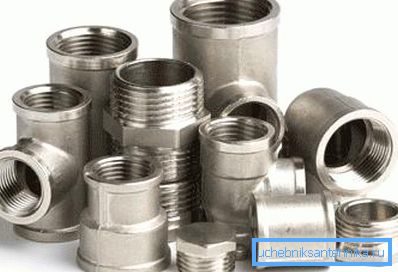Fittings for heating radiators: types and installation
Works related to the installation of the heating system require utmost care. And here not to manage the acquisition of only heating appliances. For the system to work fully, you will have to prepare a lot of components, among which there will definitely be fittings. They allow connecting the pipes of the heating system into a single pipeline and differ in the method of fastening. More about them and will be discussed later in the article.
Fixation with a pipe can be done with a thread located on the one side of the fitting, and on the other hand screwed to it with a nut. The other type has no thread, therefore, it allows only to connect parts of the system of the same size or to arrange them. So, below we consider what fittings are needed to connect a heating radiator, and how to use them.

Species
The separation of fittings is made according to different parameters. Depending on what operation should be performed with pipes, the appropriate components are used.
For convenience, you should separate them by purpose:
- The simplest element that allows you to connect the same pipe in a straight section is the fitting-coupling.
- If the installation of the pipeline requires the use of pipes of different diameters, their connection is possible with the help of adapters, and also sgony and nipples.

- The creation of angles is carried out with the help of special angles and taps..
- The use of tees and collectors of different diameters allows you to connect several pipelines at once on one layout. Even if the system uses the latest of different materials, they can be connected using plastic fittings.

- Crosses are used where branching occurs.. At the same time at the joints elements must have the same diameter.
- The union - a connecting part which allows to connect a flexible hose to the pump.
- The ends of the pipeline are sealed with fittings, which ensure complete tightness.
Fittings for polypropylene pipes
The modern construction market is flooded with a wide variety of fittings designed to connect polypropylene pipes in the heating system. But, despite the wide choice, choosing the required model is not so difficult, since they all have different sizes. Regardless of whether these parts are threaded or not, they can be either collapsible or solid.

The choice of the desired connection element depends on its functional purpose.
For example:
- it is much more convenient to make the hose connection using a one-piece fitting;
- Collapsible connector with threaded fastening better use for the counter.
Tip: if the pipeline is polypropylene, consider its thermal expansion.
This factor is of particular importance when installing a heating radiator. Therefore, in order to avoid exposure to the material temperature fluctuations and pressure surges, you should install the compensator. Pipeline and fittings eventually become a single system, so it’s better if they are made of polypropylene.
Tip: if you want to connect metal pipes, the threaded connection of the fitting should be brass.
Features of copper fittings
Copper pipelines are particularly practical, although their price is much higher. In addition, all related parts made from the same material and presented on the construction market in a huge range are purchased. All this allows you to perform any work related to the installation of the heating system, regardless of their complexity.

Copper fittings:
- very light;
- not exposed to high temperatures;
- not afraid of direct sunlight that can cause deformation.
This, perhaps, is their main advantage. Such elements can be used in water mains, requiring a large number of branches. Copper fittings also allow you to easily form both bends and new angles and turns.
Installation options
Below we consider the most popular cases:
| Welded |
|
| Soldering | They are made from copper or bronze and are used when installing a metal pipeline. They are fixed with a burner that allows both soft and hard soldering. Also used polypropylene products, which require an inexpensive soldering iron. |
| Crimp |
|
| Compression | With their help, you can connect any pipe, regardless of what material they are made of. These elements have gained particular popularity due to the ability to provide a reliable connection with minimal time and labor. |
| Press fittings | Allow to achieve the highest tightness, which is achieved by a sealing ring located inside the ridge. The connection of these elements with pipes is carried out with the help of special equipment - press machines. |
| Self-locking |
|

Installation
Despite the fact that the installation of fittings is not time consuming, some difficulties may be caused by the mismatch of the thread of pipes and connectors. Therefore, before starting to work, you need to learn how to connect the threaded connections in such a way as to achieve maximum tightness. As an option, the instruction suggests to use sanitary FUM tape, which compresses the thread of the parts.
Tip: in the process of tightening the fitting, make sure that the film does not move aside, otherwise it will not fall under the thread.

There is another way - using a special thread. It is wound up with its own hands in the same way as the FUM tape, but at the expense of its structure, it allows you to tighten the threaded connection accurately. After applying the thread, it is recommended not to use the pipeline for about 12 hours.
Tip: Before you use the thread, check the thread, for which screw the fitting on it and make sure that this process is free.

Only after that proceed to winding the thread, making sure that the process runs obliquely, and the thread intersects the thread all the time. And although the packaging always indicates the optimum number of turns, for greater reliability they should be increased several times.
Conclusion
Installing the heating system fittings, especially central, requires certain skills, otherwise, after an increase in pressure in the system, an accident may occur. The installation process itself does not present any difficulties, only requires compliance with the instructions.
To seal the thread it is necessary to apply sanitary FUM-tape, thread or tow. The video in this article will allow you to find additional information on the above topic.